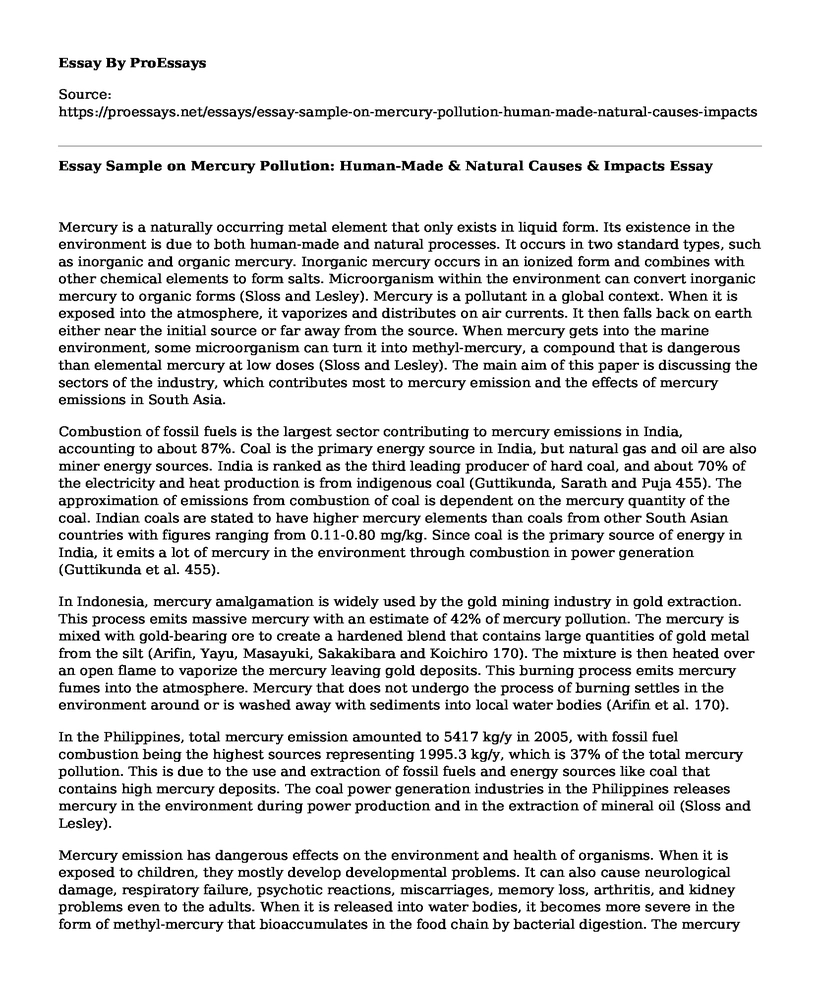Mercury is a naturally occurring metal element that only exists in liquid form. Its existence in the environment is due to both human-made and natural processes. It occurs in two standard types, such as inorganic and organic mercury. Inorganic mercury occurs in an ionized form and combines with other chemical elements to form salts. Microorganism within the environment can convert inorganic mercury to organic forms (Sloss and Lesley). Mercury is a pollutant in a global context. When it is exposed into the atmosphere, it vaporizes and distributes on air currents. It then falls back on earth either near the initial source or far away from the source. When mercury gets into the marine environment, some microorganism can turn it into methyl-mercury, a compound that is dangerous than elemental mercury at low doses (Sloss and Lesley). The main aim of this paper is discussing the sectors of the industry, which contributes most to mercury emission and the effects of mercury emissions in South Asia.
Combustion of fossil fuels is the largest sector contributing to mercury emissions in India, accounting to about 87%. Coal is the primary energy source in India, but natural gas and oil are also miner energy sources. India is ranked as the third leading producer of hard coal, and about 70% of the electricity and heat production is from indigenous coal (Guttikunda, Sarath and Puja 455). The approximation of emissions from combustion of coal is dependent on the mercury quantity of the coal. Indian coals are stated to have higher mercury elements than coals from other South Asian countries with figures ranging from 0.11-0.80 mg/kg. Since coal is the primary source of energy in India, it emits a lot of mercury in the environment through combustion in power generation (Guttikunda et al. 455).
In Indonesia, mercury amalgamation is widely used by the gold mining industry in gold extraction. This process emits massive mercury with an estimate of 42% of mercury pollution. The mercury is mixed with gold-bearing ore to create a hardened blend that contains large quantities of gold metal from the silt (Arifin, Yayu, Masayuki, Sakakibara and Koichiro 170). The mixture is then heated over an open flame to vaporize the mercury leaving gold deposits. This burning process emits mercury fumes into the atmosphere. Mercury that does not undergo the process of burning settles in the environment around or is washed away with sediments into local water bodies (Arifin et al. 170).
In the Philippines, total mercury emission amounted to 5417 kg/y in 2005, with fossil fuel combustion being the highest sources representing 1995.3 kg/y, which is 37% of the total mercury pollution. This is due to the use and extraction of fossil fuels and energy sources like coal that contains high mercury deposits. The coal power generation industries in the Philippines releases mercury in the environment during power production and in the extraction of mineral oil (Sloss and Lesley).
Mercury emission has dangerous effects on the environment and health of organisms. When it is exposed to children, they mostly develop developmental problems. It can also cause neurological damage, respiratory failure, psychotic reactions, miscarriages, memory loss, arthritis, and kidney problems even to the adults. When it is released into water bodies, it becomes more severe in the form of methyl-mercury that bioaccumulates in the food chain by bacterial digestion. The mercury released in the atmosphere distributes across the world and falls back in form of rain affecting the pH of the soil and polluting the water on a global scale (Arifin et al. 170).
Conclusion
In conclusion, mercury is a naturally occurring metal element that only exists in liquid form. Combustion of fossil fuels substantially contributes to mercury emission in India and the Philippines representing 87% and 37% of the total mercury pollution, respectively. This is because fossil fuels like coal are the primary sources of energy in these countries. In Indonesia, mercury amalgamation is widely used by the gold mining industry in gold extraction. This process emits massive mercury with an estimate of 42% of mercury pollution.
Works Cited
Arifin, Yayu, Masayuki Sakakibara, and Koichiro Sera. "Impacts of artisanal and Small-Scale Gold Mining (ASGM) on environment and human health of gorontalo utara regency, Gorontalo Province, Indonesia." Geosciences 5.2 (2015): 160-176. Retrieved from https://www.mdpi.com/2076-3263/5/2/160
Guttikunda, Sarath K., and Puja Jawahar. "Atmospheric emissions and pollution from the coal-fired thermal power plants in India." Atmospheric Environment 92 (2014): 449-460. Retrieved from https://www.sciencedirect.com/science/article/pii/S135223101400329X
Sloss, Lesley. "Mercury emissions from India and South East Asia." IEA Clean coal centre (2012). Retrieved from https://www.usea.org/sites/default/files/102012_Mercury%20emissions%20from%20India%20and%20South%20East%20Asia_ccc208.pdf
Cite this page
Essay Sample on Mercury Pollution: Human-Made & Natural Causes & Impacts. (2023, Feb 12). Retrieved from https://proessays.net/essays/essay-sample-on-mercury-pollution-human-made-natural-causes-impacts
If you are the original author of this essay and no longer wish to have it published on the ProEssays website, please click below to request its removal:
- Weather and Disasters
- Solving Sudoku Research
- Article Analysis Essay on Global Warming
- Essay Example on Trees: Our Lifeline to Climate Change Solutions
- Essay Sample on IPCC AR5: Climate Change and Its Impact on Oceans
- US Waste Management: Pros & Cons of Recycling & Landfills - Essay Sample
- Essay Example on Geography: Location, Place, and Region Explored







